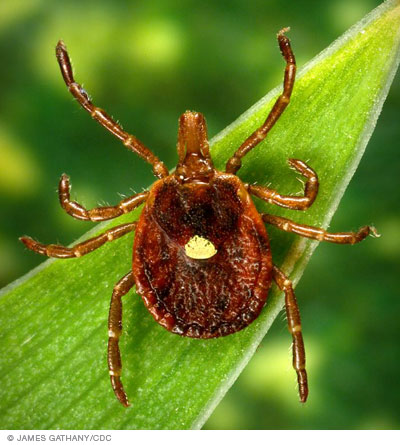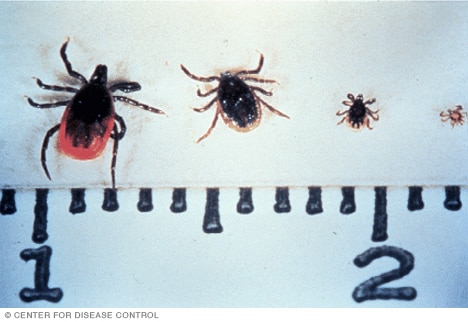Ehrlichiosis and anaplasmosis
Updated: 2022-10-05
Overview
Ehrlichiosis and anaplasmosis are similar tick-borne illnesses that cause flu-like symptoms, including fever, muscle aches and headache. Signs and symptoms of ehrlichiosis and anaplasmosis usually appear within 14 days after a tick bite.
If treated quickly with appropriate antibiotics, you'll likely recover within a few days. Untreated ehrlichiosis and anaplasmosis can result in serious or life-threatening complications.
The best way to prevent these infections is to avoid tick bites. Tick repellents, thorough body checks after being outside and proper removal of ticks are your best defenses against these tick-borne diseases.
Symptoms
Signs and symptoms of ehrlichiosis and anaplasmosis are generally the same, although they usually are more severe in ehrlichiosis. Symptoms of ehrlichiosis and anaplasmosis, which vary widely from person to person, include:
- Moderate fever
- Chills
- Headache
- Muscles aches or pains
- General feeling of being unwell
- Joint pain
- Nausea
- Vomiting
- Diarrhea
- Loss of appetite
Additional signs and symptoms associated with ehrlichiosis but rarely with anaplasmosis include:
- Confusion or changes in mental state
- Rash
Some people may be infected and not develop symptoms.
When to see a doctor
The time from getting a bite to showing signs and symptoms is usually five to 14 days. If you develop any of the signs or symptoms after a tick bite or after a possible exposure to ticks, see your doctor.
Causes

Lone Star tick
The adult female Lone Star tick displays a characteristic white spot on its back, and may grow to be as large as 1/3 of an inch before feeding.

Deer tick
The deer tick (Ixodes scapularis) goes through three life stages. Shown from left to right is the adult female, adult male, nymph and larva on a centimeter scale.
Ehrlichiosis and anaplasmosis are caused by different bacteria.
Ehrlichiosis is caused by different species of ehrlichia bacteria. The Lone Star tick — found in south-central, southeastern and eastern coastal states — is the primary carrier of bacteria causing ehrlichiosis. Black-legged ticks, commonly called deer ticks, in the Upper Midwest are less common carriers.
Anaplasmosis is caused by the bacterium Anaplasma phagocytophilum. It's primarily carried by deer ticks in the Upper Midwest, northeastern states and central Canadian provinces. It's also carried by the Western black-legged tick in Western coastal states and other tick species in Europe and Asia.
The ehrlichia and anaplasma species belong to the same family of bacteria. Although each bacterium appears to have a specific target among immune system cells in the host, all of these infectious agents generally cause the same symptoms.
Tick bites and infection
Ticks feed on blood by latching onto a host and feeding until they're swollen to many times their normal size. Ticks can pick up bacteria from a host, such as a deer, and then spread the bacteria to another host, such as a human. The spread of the bacteria from the tick to the host probably occurs about 24 hours after the tick has begun feeding.
Other ways bacteria spreads
Spread of the bacteria causing ehrlichiosis or anaplasmosis is possible through blood transfusions, from mother to fetus, or through direct contact with an infected, slaughtered animal.
Risk factors
Ticks live near the ground in wooded or brushy areas. They do not fly or jump, so they can only reach a host who brushes up against them. Factors that increase your risk of a tick bite include:
- Being outdoors in warm spring and summer months
- Participating in activities in wooded areas, such as camping, hiking or hunting
- Wearing clothes that leave your skin exposed in tick-friendly habitat
Complications
Without prompt treatment, ehrlichiosis and anaplasmosis can have serious effects on an otherwise healthy adult or child. People with weakened immune systems are at a higher risk of more-serious and life-threatening complications.
Complications of an untreated infection may include:
- Kidney failure
- Respiratory failure
- Heart failure
- Damage to the central nervous system
- Seizures
- Coma
- Severe secondary infections
Prevention
The best way to steer clear of ehrlichiosis or anaplasmosis is to avoid tick bites when you are outdoors. Most ticks attach themselves to your lower legs and feet as you walk or work in grassy, wooded areas or overgrown fields. After a tick attaches to your body, it usually crawls upward to find a location to burrow into your skin.
If you are going to be working or playing in an area that is a likely tick habitat, follow these tips to protect yourself.
Use tick repellents
- Spray your outdoor clothing, shoes, tent or other camping gear with a repellent that has 0.5% permethrin. Some gear and clothing may be pre-treated with permethrin.
- Use an insect repellent registered with the Environmental Protection Agency on any exposed skin, except your face. These include repellents that contain DEET, picaridin, IR3535, oil of lemon eucalyptus (OLE), para-menthane-diol (PMD) or 2-undecanone.
- Do not use products with OLE or PMD on children under age 3.
Dress for protection
- Wear light-colored clothing that makes it easier for you or others to see ticks on your clothing before they bite.
- Avoid open-toed shoes or sandals.
- Wear long-sleeved shirts tucked into your pants and long pants tucked into your socks.
Check for ticks
- Shower as soon as possible to wash off any loose ticks and check for ticks that may have burrowed.
- Use a mirror to check your body thoroughly. Pay attention to your underarms, hair and hairline, ears, waist, between your legs, behind your knees, and inside your bellybutton.
- Check your gear. Dry your clothes and gear on hot for at least 10 minutes to kill ticks before cleaning them.
Other tips
- Do a daily inspection for ticks on any pet that spends time outdoors.
- Stay on clear paths as much as possible in wooded and grassy areas.
Diagnosis
Tick-borne infections are difficult to diagnose based solely on signs and symptoms because they are similar to many other common conditions. Therefore, a history of a known tick bite or possible exposure to ticks is an important piece of information in making a diagnosis. Your doctor will also conduct a physical exam and order tests.
If you have ehrlichiosis or anaplasmosis, the following results are likely found from blood tests:
- Low count of white blood cells, which are disease-fighting cells of the immune system
- Low count of blood platelet cells, which are essential for blood-clotting
- Elevated liver enzymes that may indicate abnormal liver function
Tests of your blood may also indicate a tick-borne infection by detecting one of the following:
- Specific genes unique to the bacteria
- Antibodies to the bacteria created by your immune system
Treatment
If your doctor diagnoses ehrlichiosis or anaplasmosis — or suspects a diagnosis based on the symptoms and clinical findings — you'll begin treatment with the antibiotic doxycycline (Doryx, Vibramycin, others).
You'll take the drugs at least three days after you no longer have a fever and your doctor has observed improvement in other signs of disease. The minimum treatment is five to seven days. More serious illness may require two to three weeks of antibiotic treatment.
If you're pregnant or allergic to doxycycline, your doctor may prescribe the antibiotic rifampin (Rifadin, Rimactane, others).
Lifestyle and home remedies
If you find a tick on your body, don't be alarmed. Removing a tick promptly is a good defense against transmission of bacteria. Use the following steps:
- Gloves. Wear medical gloves or similar gloves if possible to protect your hands.
- Tweezers. Use fine-tipped tweezers to grab the tick firmly near its head or mouth, and as close to the skin as possible.
- Removal. Pull the tick's body away your skin steadily and slowly without jerking or twisting it. If parts of the mouth remain, remove them with clean tweezers.
- Disposal. Kill the tick by putting it in alcohol. Do not crush the tick to avoid exposure to possible bacteria. The dead tick can be flushed, lightly wrapped in tape before throwing in the trash or stored in a freezer.
- Storage. A tick can be tested at a later date if you suspect infection. Place the tick in a container, label it with the date, and place it in the freezer.
- Cleanup. Use soap and water to wash your hands after handling the tick and around the tick bite. Clean the site and your hands with rubbing alcohol.
Don't apply petroleum jelly, fingernail polish, rubbing alcohol or a hot match to the tick.
Monitor the bite site
A small, red bump, similar to the bump of a mosquito bite, often appears at the site of a tick bite or tick removal and resolves over a few days. This is normal and should not cause alarm.
If you experience continued irritation at the site or experience any signs or symptoms that may indicate a tick-borne infection, contact your doctor.
Preparing for an appointment
You're likely to first see your primary care doctor or possibly an emergency room doctor, depending on the severity of your signs and symptoms. However, you may be referred to a doctor who specializes in infectious diseases.
If a tick-borne illness is possible because of recent outdoor activities, be prepared to address the following:
- If you kept a removed tick, bring it to the appointment.
- If you were bitten by a tick, when did it happen?
- When were you possibly exposed to ticks?
- Where have you been while doing outdoor activities?
Be prepared to answer these additional questions and write down the answers before your appointment.
- What symptoms have you experienced?
- When did they begin?
- Has anything improved the symptoms or worsened them?
- What medicines do you take regularly, including prescription and over-the-counter drugs, dietary supplements, herbal remedies, and vitamins?
- Are you allergic to any medications, or do you have any other allergies?